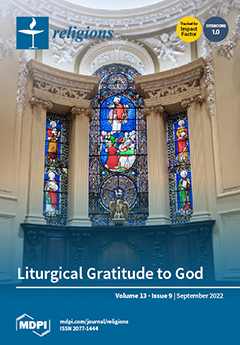Among the biblical characters used as examples in developing and explaining
satyagraha, Daniel is the most important after Jesus. In Gandhi’s speeches and writings from 1909 to 1946, Daniel served as the ideal
satyagrahi both in South Africa and in India. Over
[...] Read more.
Among the biblical characters used as examples in developing and explaining
satyagraha, Daniel is the most important after Jesus. In Gandhi’s speeches and writings from 1909 to 1946, Daniel served as the ideal
satyagrahi both in South Africa and in India. Over time, Daniel received company in the gallery of examples in which Socrates occupied a prominent place. Depending on theme, place, and audience, past and present characters from different traditions and scriptures accompanied Daniel. They represented the development of aspects of
satyagraha: nonviolent active resistance as a weapon of the strong, courageous actions as a deliberate choice without excitement, love for the antagonist, preparedness to suffer, and no fear of death. All these aspects are embodied by the Gandhian Daniel. Gandhi emphasized the active role of Daniel as a resister, not the traditional view of the victim of court intrigues. In this paper, I argue that the image of the ideal
satyagrahi Daniel could be strengthened by combining the court narratives from the first half and the apocalypses from the second one of the biblical book. The article provides context both for Gandhi’s political and religious practice and for the book of Daniel. The strange world of apocalypses seems to contradict the model of the Gandhian figure Daniel. However, they are crisis literature, and it makes sense to observe how the protagonist and his audience in times of occupation, persecutions, and war ask for guidance. Apocalypses show how Jewish resistance to foreign rule was conceived. The result of the survey is a complex image of competing literatures from roughly the same period and the hands, heads, beliefs, and sufferings behind them. The view of the end of history, a program of nonviolence, and hope in the Daniel apocalypse serve as contrast propaganda to contemporary visions on the violent Maccabean revolt and the Seleucid persecutions. They offer a nonviolent counterweight to the ideology of the state propaganda of the Seleucids. They contradict the historiographic idealization of the Maccabean revolt and its armed resistance.
Full article





